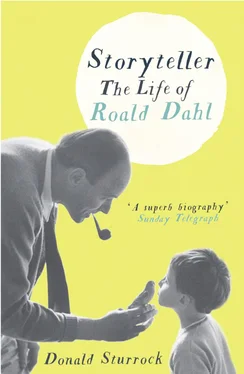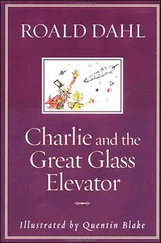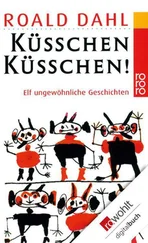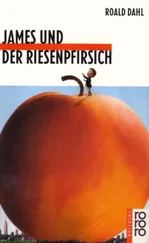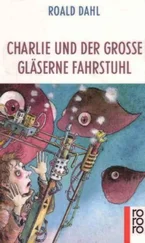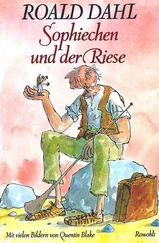Roald was only three years old when his father died. The tales of Harald’s personality and background, both real and invented, became therefore unquestioned, unexamined truths for his children. And Sofie Magdalene was largely responsible for all of them. As the years passed, she gradually cut off contact with almost all the other Dahls, creating a situation where few could contradict her version of events. The entrepreneur who left his family in Norway to find success abroad; the one-armed survivor, undaunted by adversity, who learned to cope with everything life could throw at him; the craftsman/painter living the high life in fin-de-siecle Paris; the lover of nature, the proponent of “glorious walks”; the grieving father, who lost the will to live. All these aspects of Harald’s personality came to acquire talismanic qualities for his young son, who used them to help define himself. In later life, when things got difficult, sometimes he found himself looking for father figures who could measure up to this ideal. But he never inquired too deeply as to the veracity of the stories about his own father. They were too ingrained in his own personality. The legend of Harald, passed on to his children by his devoted wife, was perhaps the most powerful of the many myths of which his mother was the prime architect. Much of what she said, of course, was true. Yet Sofie Magdalene would later admit, in moments of weakness, that her husband had not been an entirely easy man to live with. For her young children, however, and for Roald in particular, Harald would always be the ideal “papa”.
Roald criticized his father for only one thing: leaving an intricate, complex and controlling will, which suggested a distrust of his wife and which made the family’s day-to-day survival much more difficult than was necessary. His plans were predicated on the assumption that Sofie Magdalene would marry again, so the bulk of the estate was left in a trust that was constructed more in favour of his children than his wife. But she remained a widow, and the result was that she was left with very little direct control of the family finances. Although she was one of the trustees, Sofie Magdalene still had to get approval from the other two trustees, her brother-in-law Oscar, and Ludvig Aadnesen, for almost everything she bought for the household. This was time-consuming and Sofie Magdalene sometimes also found it humiliating. The estate was large. In 1920, it was valued at over £150,000. 11In today’s terms its equivalent could be reckoned about £5 million (or $7.5 million). Harald’s family in Norway were not entirely forgotten, but the bequests to them were small ones. He left £100 to each of his sisters, but to his eighty-six-year-old father, Olaus, who was still alive, and living in poverty in Kristiania in a tiny flat, and to his brother Truls, who had taken over the family business as pork butcher and sausage maker, he left nothing. Almost all of his wealth was left to his children.
One might have thought that the income from the modern-day equivalent of £5 million would have been enough for the Dahl family to go on living in Radyr, but it was not, and their life as rural landowners was abruptly terminated soon after Asta — “Baby”, as she became known — was born in the autumn of 1920. By Christmas, the beloved farm was put on the market, the animals auctioned off, and the servants dismissed. From that moment onward, Radyr, with its turrets and fields, occupied an idealized place in the minds of the Dahl children, and the house came to embody a kind of paradise, irretrievably taken from them at a very young age. This sense of loss is echoed in many of Roald Dahl’s books, most strikingly perhaps in James and the Giant Peach, where, on the very first page “the perfect life for a small boy” — which in this instance involved beaches, sun and sand rather than horses, fields and servants — comes to an abrupt end. James’s parents had been up to London to go shopping (always a mistake in Dahl’s eyes) and there they met a terrible, if hilarious fate — “eaten up in full daylight, mind you, and on a crowded street, by an enormous angry rhinoceros that had escaped from London Zoo”. Though this was “a rather nasty experience” for them, Dahl reflects, “in the long run it was far nastier for James”. His parents’ end had been swift and relatively painless. Their son, on the other hand, was left behind, cut off from everything familiar and everyone he loved: “alone and frightened in a vast unfriendly world”. 12
So Radyr was sold. The family, with Birgit the nanny and a couple of maids, moved back to Llandaff, into a “pleasant medium-sized suburban villa” 13called Cumberland Lodge, now part of Howell’s School, which was also near the home of Ludvig Aadnesen. It was a comfortable existence, if less grand than life in Radyr. But there were consolations for a young boy. Its principal attraction was a large garden, with a swing and some rudimentary cricket nets, where Roald, already a keen sportsman, could practise his batting. Even more important than the garden was the man who worked there — a fellow whose real name was Jones, but whom the children called Joss or Spivvis. “Everyone loved him,” Dahl would later recall, “but I loved him most of all. I adored him. I worshipped him, and whenever I was not at school, I used to follow him around and watch him at his work and listen to him talk.” Every Saturday in the winter, when there was a home match, Joss would take young Roald to Ninian Park, to see Cardiff City, the local football team. Roald was already tall enough to see over many people’s heads and clearly relished the experience of being away from a house full of women. “It was thrilling to stand there among those thousands of other men,” he later wrote, “cheering our heroes when they did well and groaning when they lost the ball.” The experience gave him “an almost unbearable sense of thrill and rapture”, and contrasted with his feelings toward his first school: a local kindergarten called Elm Tree House, run by two sisters, Mrs Corfield and Miss Tucker. Their “sweet and smiling” faces made little impression on him and few memories of his short time there would linger in his brain. 14One alone remained fresh. The swashbuckling thrill of riding his new tricycle down the road to school and leaning into the corners so steeply that only two of the cycle’s three wheels touched the ground.
Roald’s next school would be much more memorable. Llandaff Cathedral School, an elegant three-storey Georgian building, constructed in the shadow of a medieval cathedral, is an educational institution with a pedigree that dates back to the ninth century. Roald’s elder brother Louis had been sent there, and though Sofie Magdalene was already planning a move to England, she was not yet quite ready to leave Wales. The school was also a stone’s throw from Cumberland Lodge and so it was the natural place to send Roald after his year with the smiling sisters. He went there in 1923, at the age of seven, and stayed for two years. Of all the incidents he would later recall there, one adventure stood out above the others. It was both exciting and traumatic, and contained three ingredients that would come to characterize his later children’s fiction: a sweetshop; a foul old hag; and violent retribution. In Boy, he introduces the story with a fanfare that is both swaggering and yet deliciously ironic. “When writing about oneself, one must strive to be truthful,” he begins. “Truth is more important than modesty. I must tell you therefore, that it was I and I alone who had the idea for the great and daring Mouse Plot. We all have our moments of brilliance and glory,” he concludes, “and this was mine.” 15
The story is a simple one. A boy finds a dead mouse under the floorboards at school. Along with a group of friends, Roald decides to use it to play a trick on the ugly and bad-tempered proprietor of the local sweetshop, Mrs Pratchett. He takes the dead mouse into the shop and when she is not looking, drops the mouse into a glass jar of sweets. Mrs Pratchett is so shocked when she opens it and finds the dead rodent that she drops the jar to the ground, where it shatters in pieces. Furious, she tracks down the offenders and takes revenge on them by ensuring they are ferociously beaten. A simple enough tale of a schoolboy prank that goes wrong, you might think. But not for Roald Dahl. For his sensitive child’s antennae, this is an adventure story of grandiose proportions — enacted with buccaneering style and panache. Its setting, a sweetshop, is the centre of the universe. It is “what a bar is to a drunk, or a church is to a Bishop” — the most important place in town. Despite the suspicion that the tasty liquorice bootlaces may be made from rat’s blood, or that the Tonsil Ticklers are infused with chloroform, the contents of its jars and boxes are objects of reverence and profound fascination. Dahl and his young accomplices are a “gang of desperadoes”, locked in mortal combat with the hideous villain of the piece, Mrs Pratchett, a comic distillation of the two witchlike sisters who, it seems, ran the shop in real life. 16She is “a small, skinny old hag with a moustache on her upper lip and a mouth as sour as a green gooseberry”. She has “goat’s legs” and “small malignant pig-eyes”. Her “grimy hands” with their “black fingernails” 17dig horrifyingly deep into the fudge as she scoops it out of the container. She is a typical Dahl enemy — cruel, bony, repulsive and female — and she wreaks a savage revenge on her five child tormentors, insisting that they are each caned by their headmaster while she sits in a chair, enthusiastically egging him on to greater violence.
Читать дальше
